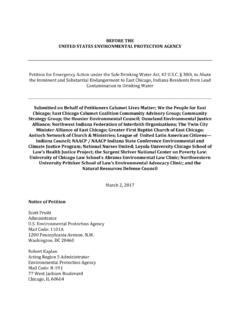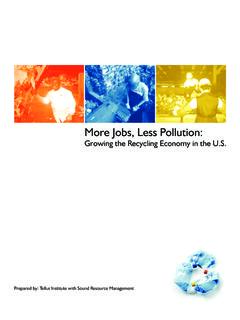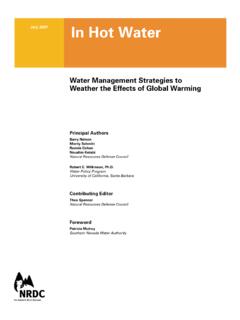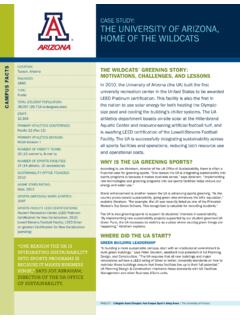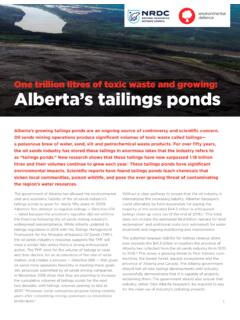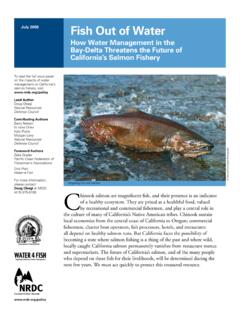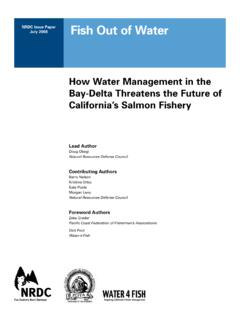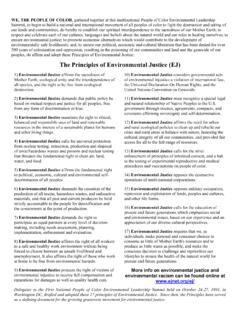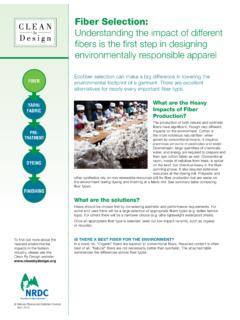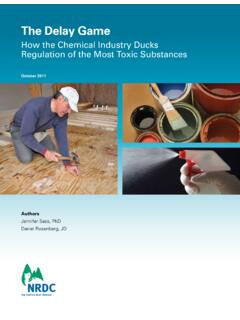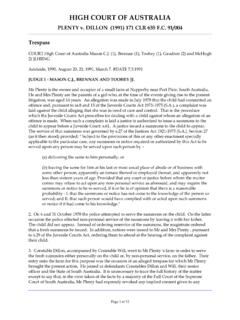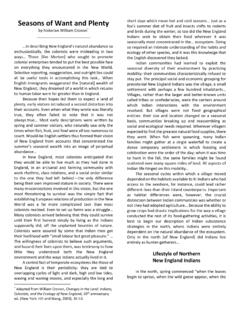Transcription of The dark mass of a Harmful Algal Bloom below the surface ...
1 HealthFactsTides of Trouble: Increased Threats to Human Health and Ecosystems from Harmful Algal BloomsThe proliferation of Harmful Algal Blooms (HABs) is a matter of growing global environmental health concern. These dangerous blooms of tiny microalgae can produce potent toxins that can harm people, pets, and marine life, and contaminate aquatic food chains. Eating toxin-contaminated fish or shellfish, swimming in or drinking contaminated waters, or breathing the air on beaches affected by these toxins can cause acute and long-term illness, and even death. Symptoms can be particularly severe in the elderly or those with pre-existing respiratory conditions. For example, for people with asthma, spending even one hour at a beach affected by red tide, where toxins can become airborne, can hamper breathing days later and these aerosolized toxins can travel up to a mile inland.
2 Coastal communities in the United States are affected every year by HABs, with individual events costing local economies tens of millions of dollars. Climate change may be contributing to the conditions that allow these blooms to flourish, with waters becoming warmer and more frequent heavy rains washing nutrient-rich runoff into waterways. To address this rising tide of trouble, NRDC recommends increased support for research, adoption of improved policies and regulations related to monitoring for and responding to HABs, and several easy steps for protecting personal health and safety while at the more information, please contact: Kim Knowlton at (212) 727-4579 2010 Natural Resources Defense CouncilThe dark mass of a Harmful Algal Bloom below the surface of the water, which can produce serious health impacts.
3 Paul Schmidt, Courtesy of Charlotte Sun HeraldHarmful Algal Blooms Can Cause Human Illnesses and Economic ImpactsSome 76 million cases of foodborne illness are reported annually in the United It has been estimated that nearly 20 percent of foodborne disease outbreaks in the United States may result from seafood consumption, with as many as half of those the result of naturally occurring Algal toxins (in particular, Ciguatera Fish Poisoning; see map and table).2 Unfortunately, Algal toxins are not destroyed by From 1993 to 2002, more than 550 cases of HAB-related illnesses were reported by the Centers for Disease Control and Prevention (CDC), although this is considered a low estimate since it is believed that seafood-related illnesses are under-reported, misdiagnosed, and possibly The risk of human illness from Algal toxin exposure can be greatly reduced or prevented through harvesting closures and beach warnings, which are issued based on data provided through rigorous state monitoring programs.
4 The economic costs of just one type of widespread HAB in the United States, the blue-green algae Microcystis, has been estimated in excess of $82 million annually, including public health, fisheries, and tourism In addition to human illness, there were 14 confirmed canine pet deaths in the United States from HAB exposures as of to Protect Yourself and Your Family from HABs:7 The CDC recommends taking the following steps to protect your health when you suspect that waters are affected by HABs:n Pay attention to postings: don t enter waters closed by local public health authorities, and heed shellfish and fishing advisories posted in sport-fishing areas. n If you are in contact with algae-contaminated water, rinse off your skin with fresh water as soon as possible. n Report musty-smelling or -tasting drinking water to your local water provider.
5 N Report any HAB-related illness to your physician and make sure they submit the information into available HAB-health reporting systems, since under-reporting is an issue. Tides of Trouble: Increased Threats to Human Health and Ecosystems from Harmful Algal Blooms Health Facts HAB-Related IllnessAmnesiac Shellfish Poisoning (ASP) Diarrheic Shellfish Poisoning (DSP) Neurotoxic Shellfish Poisoning (NSP) Red Tide Respiratory Irritation Paralytic Shellfish Poisoning (PSP) Ciguatera Fish Poisoning (CFP) Estuary-Associated Syndrome Blue Green Algae (Cyanobacteria)ToxinDomoic acid from diatoms Okadaic acid from dinoflagellates Brevetoxins from dinoflagellate Karenia brevis Brevetoxins Saxitoxins from dinoflagellates or pufferfish Toxins from dinoflagellates Pfiesteria toxins from dinoflagellates Anatoxins, microcystins, lyngbyatoxins, BMAA (toxic amino acid), adapted from: Sandifer P, Sotka C, Garrison D, Fay V.
6 (2007); and Van Dolah (2000)TABLE: HAB-Related Illnesses, Toxins, Sources, and Adverse Health Effects8 Route of ExposureConsumption of contaminated shellfish and possibly fish. Consumption of contaminated shellfish. Eating contaminated shellfish and possibly fish; called Red Tides because of reddish haze produced on ocean of airborne toxin in aerosolized seawater. Eating contaminated shellfish and fish. Consuming contaminated large reef fish, especially barracuda; has become one of the most common fish-related illnesses in Exposure to air or water contaminated by toxins from a fish-killing dinoflagellate that occurs in brackish contact with, or inhalation or ingestion of contaminated of HAB-Related IllnessVomiting, diarrhea, abdominal pain, and neurologic effects (confusion, loss of memory, disorientation, seizure, and coma).
7 Abdominal pain, diarrhea, chills, headache, fever, nausea, vomiting. Could be a tumor , muscle aches, reversal of sensations of hot and cold, diarrhea, vomiting, seizures, paralysis, and tingling/numbness of lips, tongue and eye irritation, respiratory distress, cough, and nasal irritation. Can complicate respiratory problems like , numbness, diarrhea, nausea, vomiting, loss of motor control, drowsiness, incoherence. Can be fatal. Abdominal pain, nausea, vomiting, diarrhea, dizziness, numbness, tingling, reversal of hot/cold sensation, pain, weakness. Neurological symptoms can last and eye irritation, fatigue, headache, short-term memory loss, and confusion. Skin and eye irritation, digestive, respiratory, neurological symptoms. Linked to ALS, Alzheimer s, and Parkinson s Connection Between Climate Change and Harmful Algal BloomsAlthough Bloom frequencies and distributions are variable, in the last 30 years HAB events have been increasing in their reported frequency and distribution.
8 The extent of their impacts on human health, natural resources, and local economies throughout the world has also While shorter-term weather events and human activities play key roles in the actual location, magnitude, and timing of blooms, climate change can affect the risks of HABs occurring in many marine and freshwater bodies. Several studies suggest that this rise is likely to continue, and that several aspects of climate change may create conditions favorable for their According to the Intergovernmental Panel on Climate Change (IPCC), a worldwide increase in Algal blooms is among the very likely impacts to stem from climate change as it influences environmental conditions that can have impacts on the growth toxicity and geographic distribution of species associated with Some ways climate change can influence HABs include: n warming temperatures and changing sunlight conditions that can alter species interaction and ecological processes; n changing rainfall that washes nutrients, sediments, and contaminants into waterways.
9 And n alterations in wind and current patterns that can affect species distribution, nutrient upwelling, and vertical stratification, and As noted above, one potential influence of climate change on HABs is more frequent heavy rainfall events, which can wash nitrogen-rich fertilizer, sewage, or sediment off the land and into water, and increase nutrient loading into waterways. The amount of rain falling in the heaviest 1 percent of downpours has increased 20 percent in the past century in the United States, a trend very likely to continue with climate Distribution of Harmful Algal Blooms in the United StatesPSP: Paralytic Shellfish Poisoning; ASP: Amnesiac Shellfish Poisoning; CFP: Ciguatera Fish Poisoning; NSP: Neurotoxic Shellfish Poisoning; DSP: Diarrheic Shellfish Poisoning. Note that dots represent the occurrences of the organisms and toxins that cause these syndromes, not the human health source: It is projected that global warming will also cause water temperatures to continue to rise.
10 Already, in marine and freshwater bodies, temperatures are rising during both winter and summer because of global With scientists now studying the complex factors that affect when and where toxic HABs occur, some studies suggest that HAB species will be able to invade new areas due to warming water temperatures. In some freshwater lakes, warmer temperatures allow HABs to exploit longer stratification periods and thrive, and droughts that increase lake salinities can also favor Some Harmful HAB species that were previously constrained by temperature have already expanded their ranges into more northern waters in areas of the North Sea and off the Atlantic and Pacific Coasts of ,18 Others have been shown to have longer periods of Bloom activity, such as in the Puget Sound and The map shows the tremendous variety of HABs (and their toxins) that have been reported to occur in waters.
